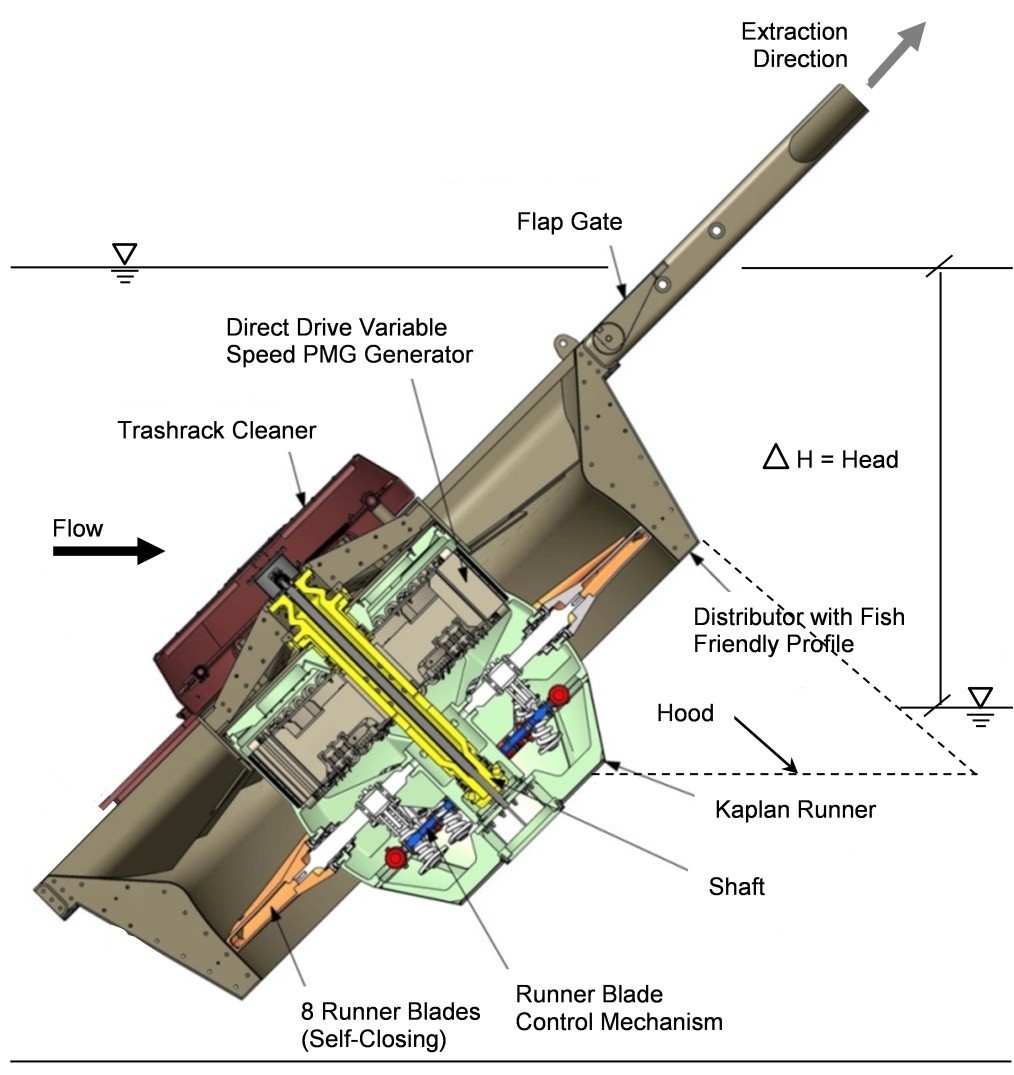Lead Proponent: Enbridge Inc. (Wasdell Falls LP)
Location: Severn River, Washago, Ontario
ecoEII Contribution: $ 2,000,000
Project Total: $ 13,990,000
Project Background
The development of very low head sites (less than 5 meters) is technically possible but not economical with traditional hydro technology, due to the complex civil structures required to direct the water from the intake to the runner in order to recover the kinetic energy at the runner exit. In the early 2000’s, Canadian and French researchers developed the VLH (very low head) turbine for water drops of less than 5 meters. The VLH turbine concept was developed by MJ2 Technologies in collaboration with Laval University. VLH turbines are designed specifically for installation into existing structures, such as dams and by-pass channels - a massive step forward in minimizing cost, construction time, and environmental impacts.
Over the last decade, more than 50 VLH hydro units have either been put into operation or are under construction in Europe. However, up until the “Wasdell Falls Hydro Power Project”, Canada had net yet capitalized on the benefits of VLH power. In 2001, Coastal Hydropower Corp. and Enbridge Inc. jointly purchased Wasdell Falls Power Corporation and assets, including the 40-year power purchase agreement and completed environmental assessment for a 1.65 MW hydro project at Wasdell Falls. Coastal Hydropower had undertaken an evaluation of modifications required for successful deployment of VLH in Canada, including design changes proposed in VLH cold-climate adaptation studies to allow year-round turbine operation in ice covered rivers. The company proposed the Wasdell Falls project for ecoEII funding and was awarded $2,000K. A separate entity, Wasdell Falls Limited Partnership (WFLP) was formed to construct, own and operate the Wasdell Falls hydro facility upon completion.
Results

The turbine structure including the extraction frame designed for Wasdell falls
Text version
Here you can see the turbine blades connected to the central shaft and generator. The flap or crest gate serves two functions, first is to allow for water flow control, but this is also used in operations to pass debris from the river (eg. Logs) over the top of the turbine.
MJ2’s VLH is an integrated turbine-generator set, incorporating a Kaplan runner with eight adjustable blades, a distributor composed of 18 fixed guide-vanes separated by radial trash rack bars, a permanent magnet generator directly coupled to the runner, and an automatic trash rack cleaner mounted on the nose of the distributor. The unit is intended to be mounted in an inclined position, with the turbine between 30° and 50° from horizontal.
In collaboration with MJ2 and supported by a Canadian engineering firm, the following modifications were made to three 550kW VLH turbines: heating mechanisms for the turbine generators, larger flap gates to allow the flushing of debris and ice, protective matting on the draft hood to protect against ice, and icephobic coating for the turbine frame, distributor and blades. These modifications enable the turbines to operate in cold Canadian winters. Moreover, a hydraulic based extraction frame was developed to facilitate turbine removal during icy conditions. The new system is capable of fully extracting a turbine from the river, under hydrodynamic pressure.

Aerial view of Wasdell Falls
Text version
On the left side of the picture is the existing water control structure with 7 separate bays. On the right is the VLH structure with the three turbines. You can also see the forebay for the VLH structure along with safety booms on the river. The “island” in the centre houses a backup generator for emergency power for both the dam and VLH structure.
Construction at Wasdell Falls started in late September 2013. Due to factors including but not limited to the re-configuration of the interconnection line and severe winter weather conditions experienced at the site, construction was not completed until May of 2015. The three modified VLH turbines were installed in a new, purpose designed and built flow channel at the Wasdell Falls weir to allow for monitoring and testing over the following years. The turbines were then connected to the provincial power grid via a partially buried interconnection line. Commissioning was interrupted due to lack of available river flow during late summer and into early fall 2015. On December 2, 2015, Wasdell Falls began commercial operations.
Benefits to Canada
Opportunities abound in Canada. VLH turbines can potentially be deployed in hundreds, perhaps thousands, of existing water control structures across Canada that have the correct characteristics of head and flow, and can produce renewable power where traditional turbines cannot.
Next Steps
VLH turbines have a relatively large diameter which allows for relatively low RPM of the turbine. According to test results completed in Europe, they are considered to be fish-friendly. Testing to confirm the European experience began in the summer of 2017 at Wasdell Falls and will continue over the next 3 years. Turbine performance, specifically during the cold winter months, will be monitored for five years after project completion. Future projects could be built directly into the bays of the existing dam at Wasdell Falls.